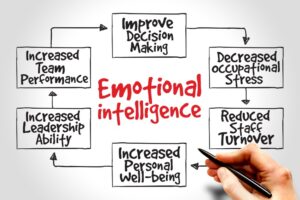By Rose O. Sherman, EdD, RN, NEA-BC, FAAN
 Over the past three decades, the importance of leader emotional intelligence has been widely recognized. It was popularized in 1995 by Daniel Goleman with the publication of his best-selling book Emotional Intelligence. Emotional intelligence (EQ) is usually defined as self-mastery or the ability to understand and control what we feel (our emotions) and the way we act (our response to these emotions). It is about self-awareness, self-management, social awareness, and relationship management. There are 4 components of EI:
Over the past three decades, the importance of leader emotional intelligence has been widely recognized. It was popularized in 1995 by Daniel Goleman with the publication of his best-selling book Emotional Intelligence. Emotional intelligence (EQ) is usually defined as self-mastery or the ability to understand and control what we feel (our emotions) and the way we act (our response to these emotions). It is about self-awareness, self-management, social awareness, and relationship management. There are 4 components of EI:
- Self-awareness – You recognize your own emotions and how they affect your thoughts and behavior, know your strengths and weaknesses, and have self-confidence.
- Self-management – You can control impulsive feelings and behaviors, manage your emotions in healthy ways, take the initiative, follow through on commitments, and adapt to changing circumstances.
- Social awareness – You can understand other people’s emotions, needs, and concerns, pick up on emotional cues, feel comfortable socially, and recognize the power dynamics in a group or organization.
- Relationship management – You know how to develop and maintain good relationships, communicate clearly, inspire and influence others, work well in a team, and manage conflict.
Increasingly, we also see that these same concepts can be applied to teams. Team emotional intelligence (EI) refers to the ability of a team to recognize and manage emotions in themselves and others effectively. High levels of team EI can help teams work more effectively and efficiently, leading to improved outcomes and stronger team performance. Teams with high levels of EI are typically more cohesive, able to handle stress and change effectively, and work well together to achieve common goals. On the other hand, teams with low levels of EI may struggle with conflicts and communication breakdowns, leading to decreased productivity and poor performance.
So how do we foster this on our teams? The first step is to educate staff about team emotional intelligence. EI is a collective responsibility and requires team members to prioritize the group’s emotions and social interactions. Teams with high EI think about the impact their behaviors and actions will have on the group. For example, negativity is a strong emotion and can quickly influence team dynamics and relationships. Moods, both positive and negative, can quickly spread throughout the team.
Additional strategies to build team EI include the following:
- Ask the team about the role that emotions play in their team interactions.
- Discuss the role of stress on teams and how to manage it collectively.
- Set team norms and ground rules.
- Use the circle of influence to discuss what the team can and cannot control.
- Promote a culture of feedback.
- Be proactive in discussing any “elephants in the room” that the team may not be surfacing. Ask – What is the real issue here?
- Encourage more open communication and honesty – ask for points of disagreement.
- Use coaching questions such as – what impact do you think your words (or behaviors) have on other team members? OR Have you brought that concern up in the team huddle?
- Work with the team in practicing active listening and empathy.
- Encourage frequent check-ins with other team members to see how they are doing and if they need help.
- Be proactive in helping the team to navigate conflict.
- Inspire team members to be authentic but also take responsibility for how their behavior and words land on others.
- Providing opportunities for team members to bond and build relationships.
Helping a team to achieve a higher level of emotional intelligence takes intentionality. Team emotional intelligence cannot be built when team members say – Well, that is just who I am.
Reference
Goleman, D., (1995) Emotional Intelligence, New York, NY, England: Bantam Books, Inc.
Greaves, J. (2021). Team Emotional Intelligence 2.0: The Four Essential Skills of High-Performing Teams. Talent Smart Publishers.
Book your 2023 Leadership Development Programs Now – Two New Programs Available Virtual or Onsite – For Nurses and Other Healthcare Leaders
From Traditional Nurse Leader to Nurse Leader Coach – Click Here for the Flyer
Rebuilding Your Nursing Team in 2023: Coming Together after Falling Apart – Click Here for the Flyer
Our Most Popular Right Now – Nurse Recruitment and Retention in Turbulent Times – Click Here for the Retention WS Flyer
For new leaders and emerging leaders, consider doing The Nuts and Bolts of Nursing Leadership Program – Click Here for the Nuts and Bolts Flyer Final
New Leader Development Option in 2023 – Team Coaching Designed to the Unique Needs of Your Organization Leader Coaching Brochure
Read the Nurse Leader Coach – Available at Amazon and Other Book Sellers
Recommended Book by the Association of Critical Care Nurses – The Nuts and Bolts of Nursing Leadership: Your Toolkit for Success



 LinkedIn
LinkedIn Instagram
Instagram